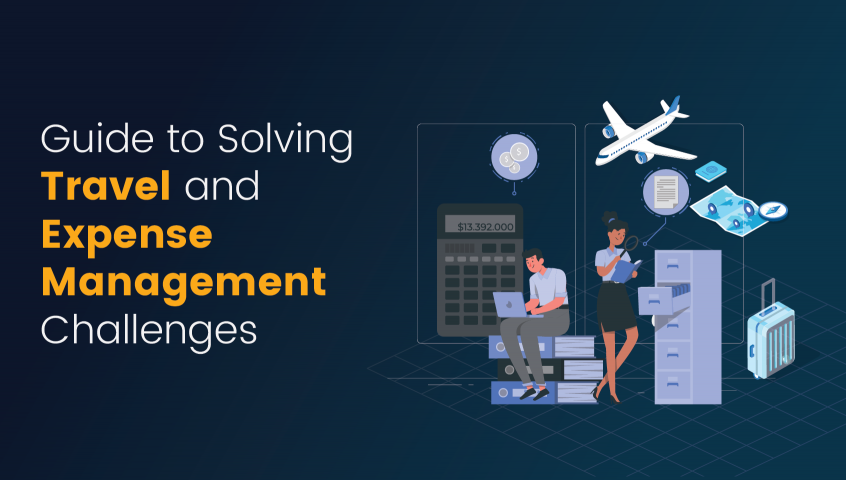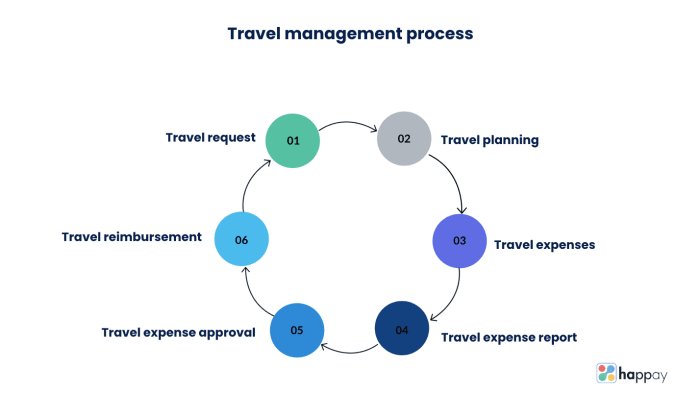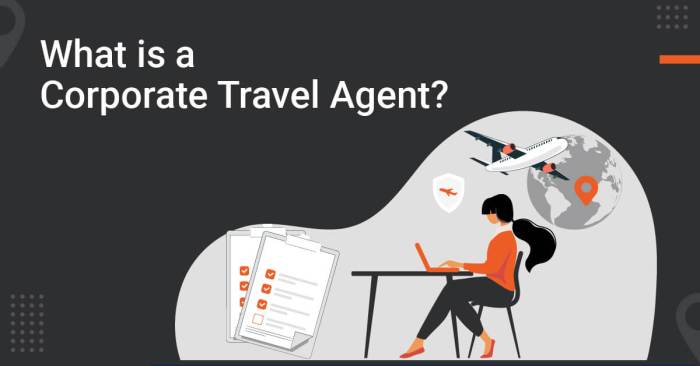Corporate Travel & Expense Management A Comprehensive Guide
Corporate travel and expense management is crucial for any organization seeking to optimize its financial resources and streamline operations. This guide dives deep into the best practices for creating a robust travel policy, effective expense reporting systems, and cost-saving strategies. It will equip you with actionable insights to improve efficiency, reduce costs, and enhance the overall travel experience for your employees.
The guide covers everything from crafting a detailed travel policy that incorporates security and safety measures to exploring various expense reporting methods (online, manual, mobile). It also delves into innovative strategies for travel cost reduction, leveraging technology to analyze spending patterns and negotiate better deals with travel providers. Tables comparing different platforms and outlining cost-cutting strategies provide practical examples to assist you in implementing these best practices.
Optimizing Corporate Travel Policies

A robust corporate travel policy is crucial for managing expenses, ensuring employee safety, and upholding company standards. Effective policies streamline the travel process, reduce risks, and foster a culture of accountability. This section details best practices for crafting such a policy.
Best Practices for Creating a Robust Policy
Establishing a comprehensive travel policy requires careful consideration of various aspects. The policy should be clear, concise, and easily understood by all employees. It should address all foreseeable situations and include specific procedures for various scenarios. It should also align with legal requirements and company values.
Expense Reporting Procedures
Clear expense reporting procedures are vital for accurate accounting and timely reimbursement. The policy should specify the acceptable forms of expense documentation (receipts, confirmations, etc.), required information (dates, locations, descriptions), and submission deadlines. Failure to adhere to these procedures can lead to delays in reimbursement and potential accounting issues. A detailed explanation of the process is necessary to avoid confusion and ensure accuracy.
Pre-Approval Processes
Implementing a pre-approval process is a critical step in controlling travel costs and ensuring compliance. It allows for cost-benefit analysis and prevents unnecessary expenses. The policy should articulate the criteria for pre-approval requests, the approval process, and the timeframe for responses. This process is essential for optimizing the budget and maintaining control over spending. Examples of pre-approval criteria could include trip purpose, destination, and estimated costs.
Acceptable Travel Methods
The policy should clearly define acceptable travel methods, considering factors like cost-effectiveness, environmental impact, and company image. This may include specific guidelines for choosing transportation (air, train, car), lodging (hotels, alternative accommodations), and transportation within the destination. By outlining these preferences, the policy fosters cost-consciousness and reinforces environmental considerations.
Security and Safety Measures
Security and safety are paramount considerations in a corporate travel policy. It should Artikel procedures for obtaining necessary travel visas, ensuring travel insurance coverage, and providing guidance on staying safe in unfamiliar environments. The policy should include details about emergency contacts and reporting procedures in case of unforeseen circumstances. This is essential for safeguarding employees and minimizing potential risks.
Sample Travel Policy
A sample travel policy article follows:
- Expense Reporting: Employees must submit expense reports within 10 business days of their return. All receipts and confirmations must be attached. Expenses exceeding a certain threshold require pre-approval.
- Pre-Approval: Travel requests exceeding USD 500 require pre-approval from the designated manager. This includes detailed justification for the trip, anticipated expenses, and travel itinerary.
- Acceptable Travel Methods: Employees are encouraged to utilize company-preferred travel booking platforms for cost-effectiveness. Air travel is the preferred method unless alternative transportation is demonstrably more cost-effective.
- Security and Safety: Employees are required to report any potential security concerns to the company security team and obtain necessary travel insurance. Employees should maintain updated contact information and communicate their itinerary with designated contacts.
Travel Booking Platforms and Expense Management Systems Comparison
The choice of travel booking platforms and expense management systems impacts efficiency and cost. A comparison table is provided below:
| Platform/System | Features | Pricing |
|---|---|---|
| Concur | Robust expense reporting, travel booking, and reporting tools; strong integration capabilities | Subscription-based, typically tiered based on usage |
| Sabre | Wide range of travel booking options, including flights, hotels, and car rentals; strong reporting features | Subscription-based, with pricing varying based on the level of service required |
| Expedia for Business | Offers comprehensive travel booking solutions, with integration with other business applications | Subscription-based, with pricing varying depending on the features and support levels needed |
| Booking.com for Business | Offers a wide range of hotels and other accommodations; strong integration with existing business systems | Subscription-based, with pricing dependent on the level of services and required support |
This table highlights key features and pricing models for popular platforms. Choosing the right system depends on specific company needs and budget.
Expense Reporting and Management: Corporate Travel And Expense Management

Effective expense reporting and management are crucial for maintaining transparency and control over travel and business expenditures. A robust system minimizes errors, streamlines processes, and allows for accurate financial reporting. This is particularly important for companies of all sizes, from startups to large corporations, to ensure accountability and compliance.
Expense Reporting Methods
Different expense reporting methods cater to various company needs and sizes. Understanding the advantages and disadvantages of each approach is key to selecting the optimal solution.
- Online Platforms: These platforms provide centralized repositories for expense data. They often feature automated categorization, expense tracking, and secure data storage. This allows for easy collaboration and real-time access to reports. For larger companies with many employees, this method offers significant efficiency gains through streamlined data entry and processing.
- Manual Submissions: While seemingly outdated, manual submissions can be suitable for small businesses with a limited number of transactions. Paper-based forms, spreadsheets, or email attachments are often used. However, manual methods can lead to data entry errors, inconsistencies, and potential delays in processing. This can be a burden on accounting teams.
- Mobile Apps: Mobile apps are gaining popularity for their convenience and accessibility. Employees can easily capture receipts, log expenses, and submit reports directly from their mobile devices. This facilitates real-time expense tracking and reporting, which is especially beneficial for frequent travelers. However, the effectiveness of mobile apps depends on robust security measures and employee adoption rates.
Benefits and Drawbacks, Corporate travel and expense management
The optimal expense reporting method depends on factors like company size, travel frequency, and budget.
- Online Platforms: Large companies often benefit from the centralized nature of online platforms, facilitating efficient data aggregation, analysis, and reporting. However, implementation and training costs can be a significant barrier for some organizations.
- Manual Submissions: Small businesses may find manual methods simpler to implement initially. However, the potential for errors, delays, and administrative burdens increases as the volume of expenses grows.
- Mobile Apps: Mobile apps are generally more efficient for frequent travelers, providing quick and convenient expense capture and submission. However, they might not be suitable for complex expense types or companies requiring detailed audit trails.
Automating Expense Reporting
Streamlining the expense reporting process significantly improves efficiency and reduces manual errors. Automation can encompass various steps, from receipt scanning to automatic categorization.
- Integration with Accounting Software: Integrating expense reporting software with existing accounting systems is crucial for seamless data transfer and consolidation. This reduces manual data entry and minimizes the risk of errors.
- Receipt Scanning and Categorization: Automated receipt scanning and categorization tools can significantly speed up the process and reduce the likelihood of human error. These tools can recognize expense types from receipt images, saving time and improving accuracy.
Expense Category Reporting
A clear understanding of expense categories and their corresponding reporting requirements is essential for accurate financial record-keeping.
| Expense Category | Reporting Requirements |
|---|---|
| Flights | Airline ticket details, booking confirmation, and any associated fees. |
| Accommodation | Hotel booking confirmation, room rates, and any additional charges. |
| Meals | Restaurant receipts, including date, time, location, and total amount. |
| Transportation | Public transport tickets, taxi receipts, or ride-sharing confirmations. |
| Other | Detailed receipts for all other expenses, including receipts with clear descriptions of the purchased items or services. |
Technology’s Role in Expense Management
Technology plays a crucial role in enhancing expense management processes.
- Expense Management Software: Specialized software can automate expense tracking, reporting, and approval workflows. It can integrate with accounting systems, reduce errors, and improve efficiency. Companies using such software often see substantial reductions in administrative time.
- Receipt Management Systems: Receipt management systems streamline the process of capturing and storing receipts, enabling faster expense reporting. They can automatically categorize expenses and eliminate the need for manual data entry.
Travel Cost Reduction Strategies

Source: paxes.com
Effective corporate travel management hinges on optimizing costs without compromising essential business needs. Implementing strategic cost-reduction measures can significantly impact a company’s bottom line, freeing up resources for other crucial areas. This section details key strategies for reducing travel expenses.
Corporate travel costs can be substantial, and proactive measures are crucial to manage these expenditures effectively. By negotiating favorable rates with vendors, optimizing travel routes, and leveraging technology, companies can achieve considerable cost savings. This approach not only enhances profitability but also promotes sustainable business practices.
Negotiating Better Rates with Airlines and Hotels
Negotiating favorable rates with airlines and hotels is a crucial component of travel cost reduction. Companies with significant travel volumes can leverage their purchasing power to negotiate discounted fares and room rates. This often involves establishing contracts with specific providers. These contracts can include volume discounts, preferred booking channels, and customized service packages.
Optimizing Travel Routes and Schedules
Strategic route planning and scheduling are essential for minimizing travel time and expenses. Employing online mapping tools and route optimization software can help identify the most efficient routes. Considering factors like traffic patterns, travel times, and potential delays can significantly reduce overall travel time and associated costs. A combination of real-time traffic updates and alternative route suggestions can provide flexibility in adapting to unexpected disruptions.
Leveraging Technology for Travel Spending Analysis
Advanced travel management systems (TMS) and expense reporting software allow companies to track and analyze travel spending patterns meticulously. These tools provide insights into spending trends, identify potential areas for cost savings. By analyzing data on flight choices, accommodation preferences, and transportation methods, companies can identify trends and implement targeted strategies for cost reduction.
Comparing Travel Booking Tools for Better Deals
A comparative analysis of various travel booking tools is necessary for securing the best deals. Different platforms may offer varying pricing structures, service packages, and commission rates. Careful consideration of these factors allows companies to select the most advantageous tool for their specific needs. This can involve comparing price quotes from multiple platforms, reviewing customer reviews, and understanding the specific features and functionalities each platform provides.
Table of Cost-Cutting Strategies
| Strategy | Estimated Savings Potential (Example) |
|---|---|
| Negotiate airline/hotel contracts | 10-20% |
| Optimize travel routes & schedules | 5-15% |
| Implement TMS/expense reporting | 5-10% |
| Utilize preferred travel agents | 2-5% |
| Employee training on expense reporting | 1-3% |
Note: Estimated savings are illustrative and can vary based on specific company travel patterns and negotiation power.
End of Discussion

Source: blueberrygroup.org
In conclusion, mastering corporate travel and expense management involves a multi-faceted approach. By implementing the strategies outlined in this guide, companies can optimize their travel policies, streamline expense reporting, and identify cost-saving opportunities. This leads to a more efficient and financially sound travel program, ultimately benefiting both the organization and its employees. The practical examples and tools provided offer a clear path forward for successful implementation.





